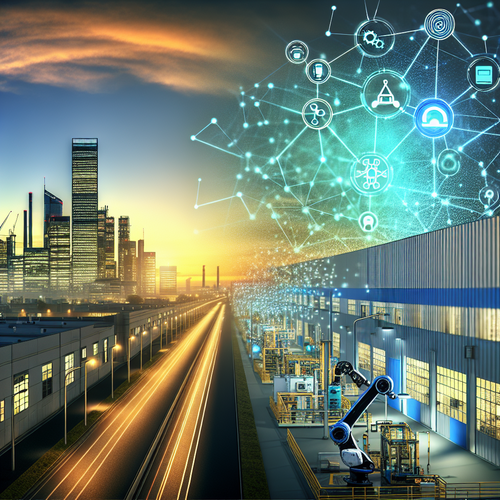Why AIoT Will Define the Future of Industry and Everyday Life 🤖🌐
Understanding AIoT’s Transformative Potential
The convergence of Artificial Intelligence (AI) and the Internet of Things (IoT), known as AIoT, is poised to revolutionize both industries and daily life by enabling intelligent connectivity. This fusion empowers devices not only to collect vast amounts of data but also to analyze and act on it autonomously. As a result, AIoT drives operational efficiency, reduces costs, and delivers highly personalized experiences. Market trends underscore rapid growth, with AIoT projected to reach unprecedented market sizes fueled by demands for smart manufacturing, connected homes, and modernized urban infrastructure. The core drivers include cost savings realized through predictive maintenance, enhanced operational performance via real-time analytics, and product or service personalization that deepens user engagement. Furthermore, AIoT fosters broader economic growth by unlocking new business models and delivering societal benefits such as better healthcare delivery, optimized traffic management, and enhanced environmental monitoring. Grasping the strategic importance of AIoT today equips stakeholders to seize transformative opportunities both now and in the future.
AIoT Technology Stack: Edge AI, Connectivity & Data Platforms Explained 🖥️📡
At the heart of AIoT lies a complex technology stack composed of multiple integral layers enabling intelligent operations. Edge AI inference takes place directly on IoT devices or gateways, enabling rapid responses with minimal latency and reducing reliance on bandwidth-intensive cloud connections. These edge devices range from simple sensors to sophisticated smart cameras, each running AI models specialized for their particular tasks.
Connectivity forms another crucial pillar: 5G networks provide high bandwidth with low latency, supporting real-time data transmission; Low-Power Wide Area Networks (LPWAN) enable long-range, low-power communications ideal for dispersed sensor networks; and private networks offer enterprises the security and control demanded by critical applications.
Cloud and data platforms complement the edge by offering robust storage capabilities, large-scale analytics, and comprehensive machine learning lifecycle management. Orchestration tools further unify deployments, software updates, and data pipelines across distributed environments.
Technical leaders face trade-offs such as when to balance edge versus cloud processing, selecting connectivity technologies aligned with specific application needs, and ensuring vendor ecosystem compatibility. Understanding these factors is vital to crafting AIoT architectures that optimize performance, cost efficiency, and scalability.
High-Value AIoT Use Cases: Industry, Smart Cities, Healthcare & Logistics 🚜🏙️⚕️🚚
AIoT unlocks substantial value across diverse sectors by enabling intelligent automation and enhanced decision-making capabilities.
– In industry, predictive maintenance algorithms analyze sensor data to predict equipment failures before they occur, minimizing downtime and cutting maintenance expenses. Autonomous operational controls optimize safety and efficiency on factory floors.
– Smart cities use AIoT to manage traffic flows dynamically, reducing congestion, and to control utility consumption smartly, optimizing energy use throughout urban environments.
– In healthcare, AIoT supports remote patient monitoring and advanced diagnostics that allow timely interventions and highly personalized care.
– The logistics sector benefits from real-time shipment and inventory tracking, which elevates route optimization and increases supply chain transparency.
Each use case depends on reliable AI inference deployed at the edge or in the cloud, robust connectivity to ensure timely data exchange, and interoperable data platforms that integrate diverse systems. Success metrics typically include reductions in operational costs, decreased downtime, faster service response times, and improved customer satisfaction.
Overcoming AIoT Implementation Barriers: Security, Interoperability & Organizational Readiness 🔐🔗🏢
Despite its promise, scaling AIoT faces significant challenges.
– Cybersecurity at the edge is critical because connected devices increase attack surfaces. Mitigation strategies include strong device authentication, robust data encryption, and continuous security monitoring.
– Data governance and privacy must comply with stringent regulations like GDPR and HIPAA, necessitating strict policies and anonymization techniques to protect user information.
– Interoperability remains a hurdle due to diverse industrial protocols and vendor solutions. Adopting standards such as MQTT, OPC UA, and emergent AIoT frameworks helps prevent vendor lock-in and enables seamless system integration.
– Organizational readiness demands cross-functional teams versed in AI, IoT, cybersecurity, and change management. Successful AIoT adoption requires a phased implementation roadmap with clear milestones, thorough employee training, and a culture that fosters collaboration.
Practical approaches to mitigating these challenges include embedding security-by-design principles across the technology stack, employing universal data models for compatibility, and aligning initiatives with industry standards to ensure sustainable and secure AIoT deployments.
AIoT Action Plan & Outlook: What to Track, Short-Term Plays, and Preparing for the Next 3–5 Years 📈🛠️
For organizations aiming to leverage AIoT effectively, a structured action plan is essential.
– Begin with focused pilot projects aimed at high-impact use cases. Define clear metrics such as cost reductions and uptime improvements to validate return on investment quickly.
– Prioritize technology choices that emphasize scalability, built-in security features, and mature vendor ecosystems to future-proof initial deployments.
– Assemble multi-disciplinary teams skilled in data science, network management, and AI development to sustain long-term success.
– Continuously monitor external factors including regulatory changes, emerging connectivity technologies like 5G/6G evolution, and trends in edge computing costs to adapt strategy dynamically.
– Short-term initiatives can focus on automating routine operational tasks and enhancing customer experiences through smart devices.
– Over the next 3–5 years, organizations should evolve toward comprehensive AIoT integration embracing dynamic orchestration, advanced predictive analytics, and intelligent automation to maintain competitive advantage and drive ongoing innovation.
This forward-looking approach positions enterprises to navigate the evolving AIoT landscape confidently and capitalize on its transformative potential. Ready to start with IoT Worlds? Contact us today!

